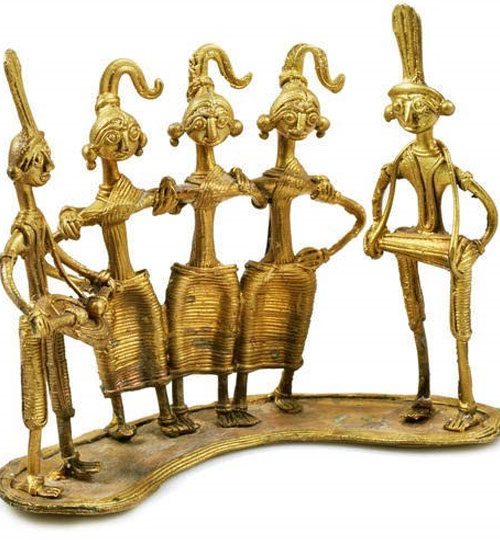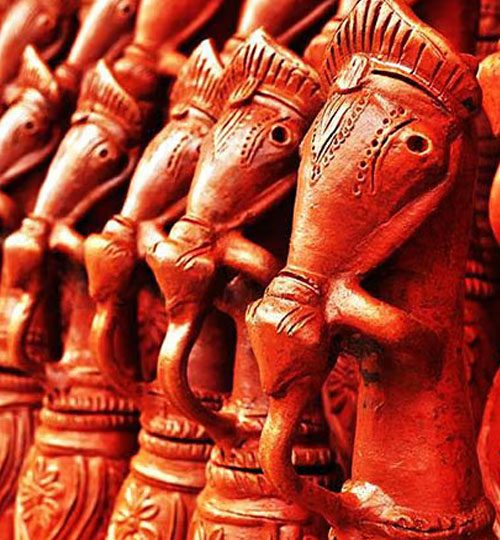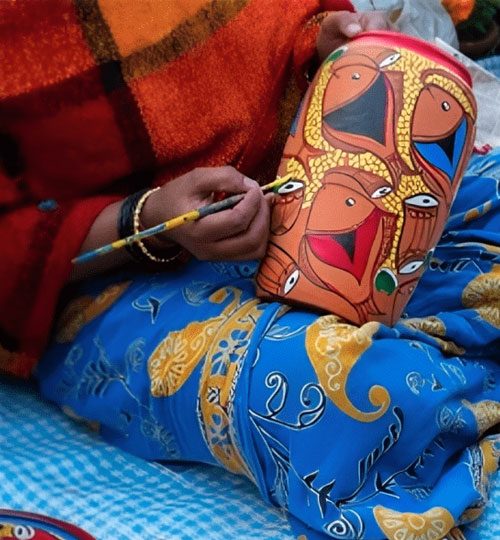Handicraft of Bengal
Notun gram Bardhaman
Natungram is a village which comes under the district of Burdhaman in the state of West Bengal. It is famous for its woodwork. Woodwork is the tradition of this small village and the skill is on full display in woodwork. The village has earned both recognition and success for its people. Carved wooden toys, wooden dolls, and musical instruments are very popular here. Other wooden items include deities and shrines.
Mango wood, Shisham wood, Bhurkul wood, Doodhia wood etc are used as raw materials. The local artisans use turmeric, Alta, Oil, Lac stick, Clay, Cloth and several other elements as raw materials to produce their product. The wood is cut from the block as per the size of the item to be made. To dry out the moisture from the wood stick it has to go through a process of slow hitting. Special care is taken while preparing an item. The painting with colour, decoration of the items and many other integral parts of article preparation are done with the finest precision. Waste products are often used to make rag dolls.
How to reach – Bardhaman is well connected by both bus and rail with Kolkata. Notungram is connected by bus from Bardhaman, Nabadwip, and Palashipara.
Kantha Stich of Nanoor Bhirbhum
Nanoor Kantha stitch is one of the famous handicrafts of West Bengal. To define Kantha we must remember that it is one of the most creative embroidery styles in our country. It is a household craft prepared by mainly rural women in West Bengal. Kantha is one of the oldest handicrafts in our country whose history dates back to thousands of years. The textile printing tradition of our state dates back a few centuries. In the book ‘Sri Chaitanya Charitamrita’ which was written five hundred years back we find the mention of Kantha. The women of rural Bengal used to prepare Kantha for religious purposes, Pujas, weddings and newborn babies. The craft and skill of embroidery often mark the feature of a particular religious community. For instance, the Hindu Kantha makers normally use the gods and goddesses, animals and birds, conch shells, and Alpanas as their designs. Muslim women are confined to plants, flowers, animals and geographical designs. Artisans select the designs very carefully. They design the patterns or forms on a sheet of paper. Paper cutting, cloth cutting, and printing and stitching are done with the finest precision.
How to reach – Nanoor is very close to Bolpur railway station which is well connected by train from Kolkata. Buses are frequently available from Bardhaman to Bolpur.




Dokra Dariapur Bardhaman
Dokra craft of Dariapur is a traditional handicraft of the rural area of Dariapur which comes under the district of Bardhaman. Dolls, animal figures, idols, and even relatively big sculptures are considered the major products of Dokra craft. The Dokra system of metal casting is believed to be the oldest form of metal casting.
How to reach – Buses are available from Bardhaman to Ausgram. Dariapur is close to Ausgram.
Dhokra craft, Bikna Bankura
The Dhokra metal casting process which is marked by the lost wax technique dates back to the Mohenjodaro period. The Dhokra people are settled in Chhattisgarh, Jharkhand, Orissa, Andhra Pradesh and West Bengal. Bankura, Bardhaman, Purulia, and Midnapore are the districts where these people are found. Coarse clay is one of the raw materials. The artisan wraps bee wax around the clay core to produce the replica. Bees-wax is often mixed with Dhuna, which is the resinous gum of the Sal tree and boiled in mustard oil. Wet clay is used to coat the replica. After drying the layer the mould becomes ready. The mould is carefully heated so that the wax melts and leaves and its loss (lost wax technique) leaves a cavity. The cavity is filled with molten metal and the mould is left to cool. Idols, animals, bowls etc are prepared in this way.
How to reach – It is very close to Bankura town
Patachitra Naya Pingla West Midnapur
Patachitra is an ancient folk art of Bengal. The word Pata is derived from the Sanskrit word “Patta” which means cloth. The artists or painters are called patuas. They paint mythological stories or tales or even contemporary issues on long scrolls of cloth. They not only paint, but they also sing when they unfurl the painting scroll to show it to the audience. These songs are commonly known as poter gaan. This group of skilful artists express themselves through their simple but beautiful paintings and touchy tunes. Their ability to use shades, different colours and vacant space in the paintings is extremely praiseworthy.
How to reach – Balichak is the nearest railway station. The village is less than half an hour from there by bus or car. On road one first reach Debra then onwards you reach Naya Pingla.
Madur Borobasudebpur – East Midnapur
The Madur mats are prepared from Madur Kathi reed that grows in the district of Midnapur in the state of West Bengal. The Madur Kathi grass from which these mats are woven grows in the swampy area around Midnapur. This school of craftsmanship is a typical feature of rural West Bengal.
How to reach – Connected from Midnapur, Haldia and Nandakumar.
Wooden mask of Kushmandi
The mask-making handicraft is one of the oldest forms in our state. These masks are mainly of mythological characters of the religious books that are made out of Skilful woodwork which are then painted with bright colours. The wooden masks of West Bengal are an integral part of our social and cultural activities.
Mask Purulia Charida
The craft of mask-making requires the highest level of skill. This musk is inseparable from the famous Chhau dance of Purulia. Chhau dance is a musk dance. After making a clay model of the mask layers of waste paper and rags are pasted on it. Once it becomes dry Paintings and decorative works are done on the dried mask. Gradually the clay is scrapped off. All these masks depict mythological stories, characters from Puranas, deities, animals, demons etc. It has become a world-famous craft due to the colourful dance form of Chhau being associated with it.
How to reach – Purulia is well connected by road and rail
Clay model Ghurni Nadia
Clay Models works of Ghurni, and Krishnagar is world famous. Ghurni is a neighbourhood of Krishnanagar in Nadia district in the Indian state of West Bengal. It is the centre for the production of clay dolls, often referred to as Krishnanagar clay dolls. These clay dolls indicate different images starting from Hindu God and Goddesses to animals, trees, different characters, daily incidents of life and even modern comic strip characters.
How to reach – Ghurni is very close to Krishnagar which is connected by rail and bus from Kolkata.
Terracotta Bankura
Terracotta craft is a well-known craft in our state. Bishnupur became the main centre for this because of the patronage of the Mall kings.
Bankura has become well known not only in our state but globally also. Panchmura has become the present centre of terracotta. Around 60 family here works on this craft. Alluvial soil is the basis to form a lump of clay with the help of little sand and fresh water from the pond. The lump thus gets ready to be pressed into dice or put on a wheel to produce the items. Several items are prepared such as horses, elephants, home utensils, conch shells, images from Ramayana, Mahabharata or Vaishnav puran, and home decorative items. The highest level of skill is required to produce these items.
How to reach – 28 km from Bankura.
Sitalpati Ghughudanga Coochbihar
Sitalpati is arguably the most popular handicraft item of Coochbihar. Sitalpati is a kind of mat. The word sital in Bengali means Cool. So it is traditionally a cool mat. The basic ingredient which is used as raw material for preparing this delicate product is Mutra cane. The cane is soaked in water and then sliced into thin strips to prepare these mats. A high level of skill is required to join and interlace thin stripes of cane to prepare these mats. While dying the stripes of cane they add colour to create patterns. These smooth, fine and glossy cane mats are designed with motifs of humans, animals, and different forms like checks, Zigzags, diamonds etc. All these motifs are skillfully woven on stripes of a cane. These beautiful mats render a feeling of coolness to those who sit or sleep on them and thus get the name Sitalpati.
How to reach – Coochbihar is well connected by bus and train from Kolkata.
Terracotta work in Bolpur.
Shantiniketan is a famous attraction in the Birbhum district of the state of West Bengal. It is very close to Bolpur. Bolpur has some other attractions which are relatively unknown and unexplored.
Surul Zamindar House – It is less than 10 km from the town of Santiniketan. Surul Zamindar house is known as Sarkarbari. You get to see a 2 storied Durga Temple when you cross the main entrance and enter into the house. This is a 300-year-old temple. There also exists an old Shiva temple. On the left side of the Durga Temple, one can see a Laxmi-Janardan Pancratna temple. The finest work of terracotta can be found on the walls of the temple. This is also an old temple built nearly 300 years ago. Two Shiva temples were built beside this temple. One specific architectural feature of Surul temples should be mentioned. On the temple wall under the layers of Chuna sand on the redbricks, instructions were written for the masons that how the bricks need to be placed while making the temple. This is a unique feature which is normally not found in any other temple. There are Paschim (west) para And Purba (East ) para. Lovely terracotta work can be found in temples in both areas. The terracotta work denotes the incidents from Purans, mythological stories and our daily lives.
How to reach – Bolpur is extremely well connected by rail from Kolkata. Surul is less than 10 km from Bolpur.
